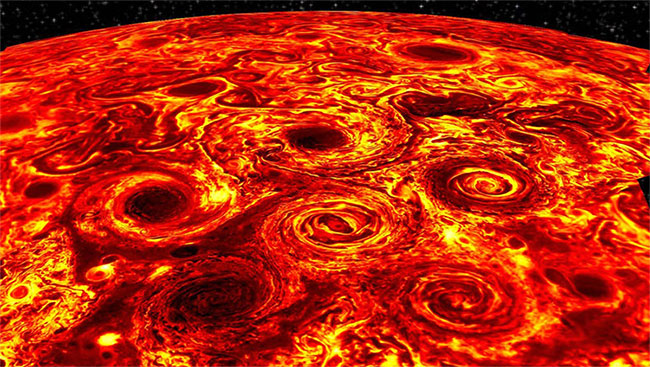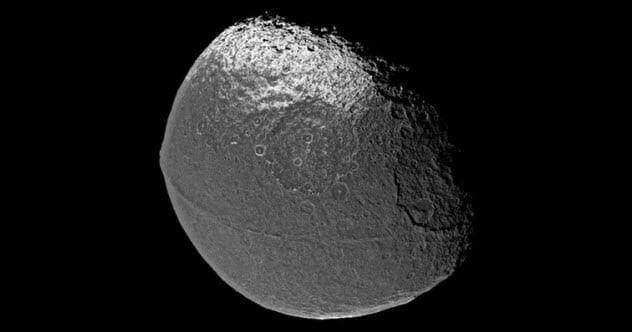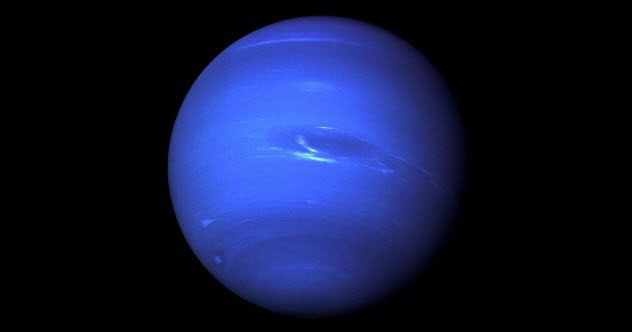10 strange natural phenomena that cannot explain in the Solar System
There are many strange things in the orbit of the Sun that astronomers have not yet liked. Here are 10 unexplained natural phenomena in our Solar System.
1. holes like honeycomb

Tornadoes exist on most atmospheric planets and moisture below the cloud - including the Earth.
The storms are called by different names, such as tornadoes or storms with the eye in the middle.
But the cyclone on Jupiter was discovered recently, completely different: Storms often form hexagons, like honeycomb around both giant gas poles.
Jupiter is not the only planet with a hexagonal storm. In 1988, scientists discovered a giant hexagonal tornado on a pole of Saturn.
However, Jupiter's beehive form seems unique. The researchers put forward many theories about the cause of these strange storms, but it is still a mystery.
2. Moon Iapetus of Saturn looks like walnuts

Imagine that the Earth gathers all the highest mountains forming a long chain on the equator. On the Moon Iapetus is similar.
This long mountain range has a maximum height of 20km, twice as high as Mount Everest. They make the Moon look like "walnut" .
3. Moon Miranda distorted

One of the most bizarre moons in the Solar System is Miranda, distorted in Uranus orbit.
Miranda has a rough surface, filled with deep craters and canyons that make it look like a "patchy moon ".
There are several theories as to why Miranda seems like patches that are stitched together. It is possible that Miranda has endured a series of disastrous effects, making it permanently scarred.
Uranus itself may have suffered many collisions at a time (leading to its horizontal orbit). This hypothesis seems reasonable.
Another theory is that Uranus's gravitational force causes Miranda to have unusual volcanic activity. rough surface
4. more heat emission

If a planet is far from the Sun, it is an icy hell, like Pluto. The warmest position on Pluto is about -223 degrees Celsius. Scientists believe that this dwarf planet once had flows of liquid nitrogen flowing through the surface.
Neptune is the most distant planet from the Sun. Its surface temperature is usually not higher than -200 degrees Celsius. Astronomers do not believe that Neptune is so cold.
However, Neptune radiates twice the amount of energy it receives from the Sun. Astronomers still don't know why. Perhaps due to diamond rain. This hypothesis is explained: Neptune's atmospheric pressure causes methane to be compressed into diamonds.
Diamonds fall into a heavy atmosphere causing friction to produce heat. This also explains the extraordinary amount of energy emanating from Neptune.
5. Seems to have infinite nitrogen supply

Pluto is so small that there is no gravity needed to hold the atmosphere. Therefore, Pluto is constantly losing hundreds of tons of atmosphere, mostly nitrogen gas when it orbits the Sun.
You may wonder why Pluto still has nitrogen. Scientists speculate that some hidden geological processes produce backup nitrogen. But the nature of that process is still a mystery.
6. in the Solar System

The 9th planet is not Pluto. Astronomers have noticed some strange gravitation in objects of the Kuiper belt (a large group of asteroids outside the orbit of Neptune).
These unusual gravity can be caused by a large planet, called the ninth planet. The most advanced telescope is also hard to find evidence of the 9th planet because it is at the edge of the Solar System.
Astronomers have estimated that if the ninth planet existed, it would be an icy world approximately three times the size of the Earth.
7. Methane gas on Mars

Although methane has been found to exist on many planets, astronomers still feel excited about it. Because methane gas is a signal of life. However, methane gas is also formed by abiotic, so it is still unsure whether life exists.
There is no large amount of methane on Earth on Mars. But the amount of small methane found on Mars is remarkable.
Moreover, methane gas appears seasonally. Scientists come up with several theories about the cause of it.
For example, it is possible that rocks on the surface absorb and release methane depending on the season. Of course, the more interesting hypothesis is the change in life methane. If this is the case, it is most likely due to bacteria living below the surface.
8. The atmosphere above the Sun is hotter than the surface

The surface of the Sun is very hot and shining. If people look directly into it, they will be blind. Although the surface temperature is about 5,500 degrees Celsius, the invisible atmosphere on the surface (called aura) can be several times hotter, from 1 to 10 million degrees Celsius.
The solar aura is very faint, only visible when eclipse. So why is it much hotter than the Sun's surface? Scientists cannot explain.
One theory is that it is hotter because millions of nanoscale sparks appear on the Sun's surface every second, transferring energy from the surface to the atmosphere above.
9. The Solar System is more exotic than the Star System

The solar system is the oddity of the universe. Astronomers have discovered that other star systems often have planets of similar size, often separated in their orbit.
The planets and moons in the Solar System are not uniform in size. Just compare the largest and smallest planets to see, like: Jupiter has 28 times the diameter of Mercury.
Also, the distance between planets is not the same as the Star System. Astronomers don't know why the Solar System is so unique. They hypothesized due to the impressive gravitational attraction of Jupiter and Saturn.
10. Gray light of Venus

The gray light of Venus is the phenomenon of dark light of this planet, first observed through a telescope in 1643.
Kim's gray light caused a scientific debate. It is described as "sunlight" , which occurs when sunlight reflected from the Earth illuminates the dark parts of the Moon.
When the moons are close to a large planet, light from the Sun can reach them in strange angles reflected on the surrounding planet.
However, this explanation is not reasonable for Venus because it does not have a large planet nearby. Astronomers tried to photograph gray light, but the light appeared randomly so it was impossible to take pictures.
Many people give up trying to prove that this phenomenon exists. Despite this, there are hundreds of reports of gray light from modern amateur astronomers. This light is very elusive and controversial so it is called "Loch Ness Lake on Venus".
- 8 natural scientific phenomena cannot explain
- The most incredible natural phenomena in the world
- Discover unique natural phenomena
- 'Rare and difficult to find' natural phenomena
- Scary but beautiful natural phenomena
- Top 15 strange natural phenomena (1)
- Strange phenomena will help you realize the true power of nature
- The most bizarre phenomena on Earth
- Strange natural phenomena only occur when it is cold
- Top 15 strange natural phenomena (2)
- Explain the 'bursting' series of 'strange phenomena' that make everyone ache
- Our solar system is quite special
 Van Allen's belt and evidence that the Apollo 11 mission to the Moon was myth
Van Allen's belt and evidence that the Apollo 11 mission to the Moon was myth The levels of civilization in the universe (Kardashev scale)
The levels of civilization in the universe (Kardashev scale) Today Mars, the sun and the Earth are aligned
Today Mars, the sun and the Earth are aligned The Amazon owner announced a secret plan to build a space base for thousands of people
The Amazon owner announced a secret plan to build a space base for thousands of people